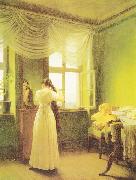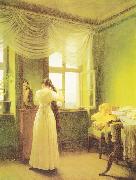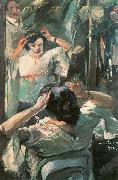Wholesale Oil Painting Reproductions No Minimum and Door to Door! |
|||||||||||
|
|
|||||||||||

|
|||||||||||
|
|
|
||||||||
All Georg Friedrich Kersting Oil Paintings |
||||||||
|
|
||||||||
|
|
||||||||
|
Artist Introduction: 1785-1847
German
Georg Friedrich Kersting Gallery
Kersting was a friend of Caspar David Friedrich, the leading German Romantic painter; his style was influenced by Friedrich, and he shared that artist's romantic attitude, although in a more subjective manner. The two friends went on a walking tour of the Riesengebirge in 1810. During his many hikes with Friedrich, the two painted numerous sketches and observations from nature. He may have painted the staffage in some of Friedrich's early work??such as Morning in the Riesengebirge (1810?C11), a result of their walking tour.
He was also a friend of the painter Louise Seidler, who described him as "an altogether splendid and comical fellow" and often served as his model. In 1813 Seidler helped Kersting send a number of his works to Johann Wolfgang von Goethe. Goethe was impressed and recommended that the Grand Duke Charles Augustus purchase his work The Embroiderer.
Kersting's most lasting works are his figures in interiors that borrow from seventeenth-century Dutch genre painting. These paintings nevertheless feel contemporary due to the situations depicted and the effect of the artist's personality. The characters are often viewed from the back, as in Friedrich's work, and the scenes provide hints of narrative as the figures engage privately in everyday activities. A number of his works refer to his time in the volunteer corps, the "L??tzow rangers". He drew a full-length self-portrait in 1813, in which he wore the rangers' uniform. The painting On Sentry Duty (1815) depicts three rangers, including the artist Ferdinand Hartmann and the writer Theodor Körner, who fought with Kersting and died in wars against the French. |
||||||||
|
|
||||||||
|
Vor dem Spiegel Painting ID:: 85771 |
Date 1827(1827)
Medium Oil on wood
Dimensions 46 x 35 cm (18.1 x 13.8 in)
cjr |
|||||||
Height Width |
INS/CM Quality |
|||||||
|
X |
| |||||||
|
|
||||||||
All Georg Friedrich Kersting Oil Paintings |
||||||||
|
|
||||||||
|
|
||||||||
|
Artist Introduction: 1785-1847
German
Georg Friedrich Kersting Gallery
Kersting was a friend of Caspar David Friedrich, the leading German Romantic painter; his style was influenced by Friedrich, and he shared that artist's romantic attitude, although in a more subjective manner. The two friends went on a walking tour of the Riesengebirge in 1810. During his many hikes with Friedrich, the two painted numerous sketches and observations from nature. He may have painted the staffage in some of Friedrich's early work??such as Morning in the Riesengebirge (1810?C11), a result of their walking tour.
He was also a friend of the painter Louise Seidler, who described him as "an altogether splendid and comical fellow" and often served as his model. In 1813 Seidler helped Kersting send a number of his works to Johann Wolfgang von Goethe. Goethe was impressed and recommended that the Grand Duke Charles Augustus purchase his work The Embroiderer.
Kersting's most lasting works are his figures in interiors that borrow from seventeenth-century Dutch genre painting. These paintings nevertheless feel contemporary due to the situations depicted and the effect of the artist's personality. The characters are often viewed from the back, as in Friedrich's work, and the scenes provide hints of narrative as the figures engage privately in everyday activities. A number of his works refer to his time in the volunteer corps, the "L??tzow rangers". He drew a full-length self-portrait in 1813, in which he wore the rangers' uniform. The painting On Sentry Duty (1815) depicts three rangers, including the artist Ferdinand Hartmann and the writer Theodor Körner, who fought with Kersting and died in wars against the French. |
||||||||
|
|
||||||||
|
|
Vor dem Spiegel Painting ID:: 89961 |
1827(1827)
Medium oil on panel
Dimensions 46 x 35 cm (18.1 x 13.8 in)
cyf |
||||||
Height Width |
INS/CM Quality |
|||||||
|
X |
| |||||||
|
|
||||||||
All Lovis Corinth Oil Paintings |
||||||||
|
|
||||||||
|
|
||||||||
|
Artist Introduction: German Painter, 1858-1925
German painter and writer. He grew up on his family's farm and tannery. As a child he showed interest in art, taking informal lessons in drawing from a local carpenter and caricaturing his primary school teachers. Corinth's father sent him to secondary school in the nearby city of K?nigsberg (now Kaliningrad), where he lived with his widowed aunt. A superstitious woman fond of story-telling, she possessed what Corinth later described as a coarse temperament and an unrestrained, 'demonic' humour. These qualities and his aunt's bohemian acquaintances, including fortune-tellers and soothsayers, fascinated the young Corinth, accustomed to his more reserved parents. |
||||||||
|
|
||||||||
|
|
Vor dem Spiegel Painting ID:: 91728 |
1912(1912)
Medium oil on canvas
Dimensions 140 X 93 cm (55.1 X 36.6 in)
cyf |
||||||
Height Width |
INS/CM Quality |
|||||||
|
X |
| |||||||
|
|
||||||||
|
Prev Next
|
||||||||
|
|
||||||||
|
Related Paintings to Lovis Corinth :. |
||||||||
|
|
||||||||
|
CONTACT US |



